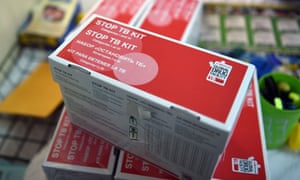Soaring rates of multidrug-resistant tuberculosis have been found in west Africa, with the highest in the dense population of Lagos, Nigeria, suggesting the seriousness of the epidemic has been considerably underestimated.
Until now, the World Health Organisation has had to rely on estimates for MDR-TB in west Africa because the data has not been collected or reliable. But a new surveillance network across eight countries in the region has found that drug resistance is a much greater threat than had been assumed.
The WHO had estimated that up to 2% of new TB infections in west Africa were resistant to drugs, but the researchers found the true rate was 6%.
The rate among people who had already been treated for TB was much higher: the WHO had estimated 17% of these infections in west Africa were resistant to drugs, but the network has found the average is 35%.
The hotspots are in Lagos, Nigeria’s largest city, where 66% of people previously treated for TB have a drug-resistant strain. Among people treated for TB for the first time, nearly a third – 32% – had a drug-resistant strain.
In Mali, the researchers found that 59% of people previously treated for TB had drug resistance.
“It is a wake-up call for the ministries of health and the governments to take MDR-TB seriously,” said Prof Martin Antonio, principal investigator at the Medical Research Council unit in the Gambia. “I think it is a problem for the rest of the world as well. Ebola wasn’t just a west African problem.
“We recommend that efforts be put in place for containment of a potential west African TB epidemic at the earliest possible stage. This is especially important as west Africa, with its 245 million inhabitants, is one of the poorest regions globally, whose fragile health systems can easily be overwhelmed by infectious disease epidemics, as seen in the recent Ebola outbreak.”

His unit is part of the West African Network of Excellence for TB, Aids and Malaria, funded by the European and Developing Countries Clinical Trials Partnership, which was set up to collect data on the three infectious diseases across the region.
The surveillance also picked up evidence of extensively drug-resistant tuberculosis (XDR-TB) in Togo and Ghana. These are strains that are resistant to second-line antibiotics used to treat MDR-TB.
The network has published its findings in the BioMed Central Medicine journal.
TB normally takes six months to cure using a combination of the antibiotics rifampicin and isoniazid, but when the bacteria becomes resistant to them a new combination is needed that is more expensive and involves longer treatment.
The latest report from the WHO found that drug-resistant cases had risen to more than 500,000 a year worldwide. The numbers of people with TB were also revised upwards, from 9.6 million to 10.4 million a year, after better data emerged from India.
Multidrug-resistant TB rates soaring in west Africa, WHO warns
Hiç yorum yok:
Yorum Gönder